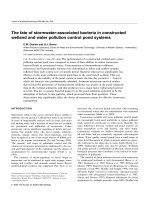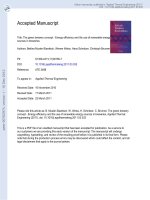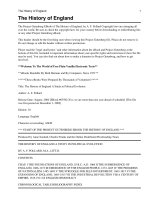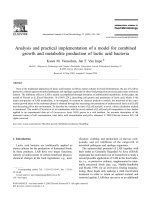The roles of lactic acid bacteria in host inflammatory responses
Bạn đang xem bản rút gọn của tài liệu. Xem và tải ngay bản đầy đủ của tài liệu tại đây (4.14 MB, 299 trang )
THE ROLES OF LACTIC ACID BACTERIA IN HOST
INFLAMMATORY RESPONSES
WANG SHUGUI
DEPARTMENT OF MICROBIOLOGY
NATIONAL UNIVERSITY OF SINGAPORE
2007
THE ROLES OF LACTIC ACID BACTERIA IN HOST
INFLAMMATORY RESPONSES
WANG SHUGUI
(B.Sc., Sun Yat-Sen University)
A THESIS SUBMITTED
FOR THE DEGREE OF PHILOSOPHY OF DOCTORATE
DEPARTMENT OF MICROBIOLOGY
NATIONAL UNIVERSITY OF SINGAPORE
2007
i
Acknowledgements
I would like to express my heartiest appreciation and deepest gratitude to the
following people:
A/P Lee Yuan Kun for his guidance, help and patience in the accomplishment of this
thesis. His deep insights and advices beyond academic and research were and will
always be well appreciated. It has been a great honor to have him as my supervisor,
and his kind guidance on my communication skills will always be cherished.
Prof. Sven Petterson and Dr. Martin Hibberd for their stimulating suggestions and
kind assistance in my research work.
Dr. Annelie, Sebastian and Chek Mei for their supports and invaluable knowledge on
my research.
Mr. Low Chin Seng for all his kind help and advices during my experiments. His
humor always cheers us up during the hard time in experiments.
Mdm Chew Lai Meng for all the encouragements and always cares about my life.
The cute people in my laboratory: Wai Ling, Hui Cheng, Choong Yun, Phui San,
Janice for their precious friendship and help which making my stay in the laboratory a
very enjoyable and memorable one.
ii
Also, Shi Wee, Juwita, Peirong, Emily, Shermine and Lydia for their friendship and
assistances in my research.
My dear friends: Zhang Jiping, Xue Xiaowei, Elicia, Zhao Jin, Zhou Yan, He Xiaoli,
Oasiser etc., for their understanding and sharing of laughter and tears with me
throughout this period.
Last but not least, I am always grateful to my family, especially my dearest husband,
for their substantial support with their endless love, caring, understanding and
encouragement in my life. Their devoted supports in every possible way enabled me
to complete this work.
iii
LIST OF PUBLICATIONS
International peer review publications
• Shugui Wang, Lydia Ng Hui Mei, Wai Ling Chow, Yuan Kun Lee. Human
intestinal Enterococcus faecalis down-regulates inflammatory responses in
intestinal cell lines. World Journal of Gastroenterology, 14 (7), 2008.
• Alexandra Are, Linda Aronsson, Shugui Wang, Gediminas Greicius, Yuan Kun
Lee, Jan- Åke Gustafsson, Sven Pettersson, and Velmurugensan Arulampalam.
Enterococcus faecalis from newborn babies enhance transcriptional activity of
endogenous PPAR-gamma through phosphorylation. In Press in Proceedings of
the National Academy of Sciences, 2008.
• Shugui Wang, Annelie Lundin, Linda Aronsson, Lydia Ng Hui Mei,
Velmurugesan Arulampalam, Sebastian Pott, Sven Pettersson, Martin Hibberd,
Yuan Kun Lee. Human intestinal Enterococcus faecalis modulates inflammation
by attenuating JNK and p38 signaling pathways. (In preparation)
• Wai Ling Chow, Shugui Wang, Yuan Kun Lee. Modulation of cytokine gene
expression in the intestinal tract of mouse by fucose. (Submitted)
iv
Conference publications
• Shugui Wang, Yuan Kun Lee, 2005, Probiotics activate distinct signaling
pathway involve in host-microbe interaction in intestinal epithelial cell. 7
th
World
Congress on Inflammation, Melbourne, Australia. Aug 20-24, 2005
• Shugui Wang, Yuan Kun Lee, 2007, Infant’s intestinal Enterococcus faecalis
suppress inflammatory responses in human intestinal cell lines. NHG, Singapore,
2007 Nov.
v
Contents
Acknowledgements i
List of Publications iii
Contents v
List of Figures xi
List of Tables xiv
Abbreviations xv
Summary xix
Chapter 1 INTRODUCTION 1
1.1 INTRODUCTION 2
1.2 AIMS OF THE STUDY 40
Chapter 2 MATERIALS & METHODS 42
2.1 BACTERIA STRAINS 43
2.1.1 Bacteria Culture 43
2.1.2 Identification of Bacteria 45
2.1.2.1 Phenotypic Characterization 46
2.1.2.2 Genotypic Characterization 46
2.1.2.2.1 Extraction of Total DNA 46
2.1.2.2.2 PCR and Sequence Analysis of the 16s rDNA 46
2.1.2.3 Protease Analysis 47
2.1.2.4 Antibiotics Resistance Test 48
2.1.2.5 Gene Tree of the Bacteria 48
vi
2.1.3 Conversion Factors 48
2.1.4 Preparation of Bacteria Strains 49
2.2 CELL CULTURE 50
2.2.1 Intestinal Cell Lines and Monocyte Cell Line Culture 50
2.2.2 Preparation of Cell Lines 51
2.3 TREATMENT OF CELLS 52
2.3.1 Co-culture of Bacteria and Cells 52
2.3.2 TNF-α and IL-1β Induced Cytokine Secretion and Protein Production
53
2.3.3 S. typhimurium Induced Cytokine Secretion and Protein Production.54
2.3.4 Protein Inhibitors Study 54
2.3.5 Adhesion Study 55
2.3.5.1 Gram Staining 55
2.4 MEASUREMENT OF CYTOKINES 56
2.4.1 ELISA 56
2.4.2 Cytokine Assay 57
2.5 BACTERIA MACRO-MOLECULES ANALYSIS 58
2.5.1 Conditional Medium and Cell Inserts 58
2.5.2 Cell Wall Component and Crude Cell Extract Preparation 59
2.5.3 Protein Digestion and Carbohydrate Oxidation of Bacterial Cell Wall
59
2.5.4 Blocking of Specific Carbohydrate Ligands and Receptors on Cell
Wall 60
2.5.5 UV- and Heat-Killed Bacteria 61
2.6 APOPTOSIS ANYLISIS 61
vii
2.7 GENE EXPRESSION ANALYSIS 62
2.7.1 RNA Extraction 62
2.7.2 RNA Quantification 63
2.7.3 Reverse Transcription-Polymerase Chain Reaction 63
2.7.4 Semi-Quantitative Gene Expression Analysis (Densitometry) 66
2.8 MICROARRAY ANALYSIS 66
2.8.1 RNA Extraction and Probe Labeling 66
2.8.2 Hybridization 68
2.8.3 Data Analysis 69
2.9 SIGNALING PATHWAY VERIFICATION 70
2.9.1 TaqMan Low Density Array (TLDA) 70
2.9.2 Western Blotting 71
2.9.2.1 Protein Harvesting 71
2.9.2.2 Bradford Assay 72
2.9.3.3 Sodium-Dodecyl Sulfate-Polyacrylamide Gel Electrophoresis
(SDS-PAGE) 73
2.9.3.4 Immunoblotting 74
2.10 STATISTICAL ANALYSIS 75
Chapter 3 SCREENING OF LACTIC ACID BACTERIA 77
3.1 RESULTS 78
3.1.1 MEASUREMENT OF CYTOKINE PRODUCTION 78
3.1.1.1 IL-8 Production in Caco-2, HT-29 and HCT116 78
3.1.1.2 Production of Other Cytokines by Caco-2, HT-29 and HCT116
82
3.1.1.3 Production of IL-8 by THP1 cells 84
viii
3.1.2 GENE EXPRESSION ANALYSIS 86
3.1.2.1 Semi-Quantitative Gene Expression Analysis 86
3.1.2.1.1 Cytokine Gene Expression Analysis 86
3.1.2.1.2 TLR Signaling Pathway Gene Expression Analysis 90
3.2 DISCUSSION 96
Chapter 4 CHARACTERIZATION OF LAB AND THEIR EFFECTOR
MOLECULES 100
4.1 RESULTS 101
4.1.1 CHARACTERIZATION OF LACTIC ACID BACTERIA 101
4.1.1.1 Phenotypic and Genotypic Characterization 101
4.1.1.2 Protease Analysis 102
4.1.1.3 Antibiotics Resistance Test 103
4.1.1.4 Gene Tree of the Bacteria 104
4.1.2 IDENTIFICATION AND CHARACTERIZATION OF POSSIBLE
EFFECTOR MOLECULES ON LAB 105
4.1.2.1 Cell Wall Components and Crude Cell Extracts 105
4.1.2.2 Conditional Medium and Cell Inserts 107
4.1.2.3 Carbohydrate Oxidation and Protein Digestion of the Bacterial
Cell Wall 110
4.1.2.4 Adhesion Study 112
4.1.2.5 UV- and Heat- Killed Bacteria 115
4.1.2.6 Blocking of Specific Carbohydrate Receptors on Bacterial Cell
Wall 116
4.1.3 APOPTOSIS ANALYSIS 117
4.2 DISCUSSION 119
ix
Chapter 5 CHARACTERIZATION OF SIGNALING PATHWAYS 124
5.1 RESULTS 125
5.1.1 MICROARRAY ANALYSIS 125
5.1.2 SIGNALING PATHWAY ANALYSIS 135
5.1.2.1 TaqMan Low Density Array Results 135
5.1.2.1.1 Results in HCT116 cells 136
5.1.2.1.2 Results in Caco-2 cells 144
5.1.2.1.3 Results in THP1 cells 147
5.1.2.2 Immunobloting Analysis 150
5.1.2.3 TNF-α, IL-1β and S. typhimurium Induced Cytokine Secretion
and Protein Production 154
5.1.2.3.1 Cytokine Production 154
5.1.2.3.2 Immunoblotting study 166
5.1.2.4 Protein Inhibitors Study 174
5.2 DISCUSSION 182
Chapter 6 CONCLUSIONS 196
6.1 Conclusions 197
6.2 Future Work 199
References 201
Appendix 1 241
Appendix 2 243
Appendix 3 246
Appendix 4 249
Appendix 5 251
Appendix 6 252
x
Appendix 7 254
Appendix 8 255
Appendix 9 258
xi
List of Figures
Figure 1.1 Micro-organisms in GI tract. 2
Figure 2.1 Overview of the Hemocytometer and the counting chamber 52
Figure 3.1 IL-8 secretions in Caco-2, HT-29 and HCT116 with the treatment of
Lactobacillus and Enterococcus 80
Figure 3.2 IL-8 secretions in Caco-2, HT-29 and HCT116 cells treated with/without
LAB for 6 hours 81
Figure 3.3 TGF-β production in Caco-2 cells treated with LAB for 6 hours 83
Figure 3.4 IL-8 production in THP1 cells 85
Figure 3.5 Different cytokine expressions in Caco-2 cells in response to LAB 88
Figure 3.6 IL-8 and TGF-β expression in HCT116 cells in response to LAB 90
Figure 3.7 TLR9, TLR4 and TRAF6 mRNA expression in Caco-2 cell line treated
with LAB 92
Figure 3.8 TLR3, TLR9 and TRAF6 mRNA expression in HCT116 cell line by EC1,
EC3, EC15, EC16, T6 and LP33 93
Figure 3.9 TLR4 and TRAF6 mRNA expression in HT-29 cell line with the treatment
of EC1, EC3, EC15 and EC16 94
Figure 4.1 Antibiotic resistance properties of E. faecalis 103
Figure 4.2 Gene tree of the 25 strains of bacteria isolated from new born infants. 104
Figure 4.3 IL-8 concentrations obtained upon treatment of bacterial cell debris, whole
bacterial cell, bacterial crude cell extracts, cell debris and crude cell extracts mixture
in HCT116 cells 107
Figure 4.4 IL-8 secretion obtained upon the treatments of conditional medium on
HCT116 cells 108
Figure 4.5 Regulation of IL-8 levels by carbohydrate oxidation and protein digestion
of E. faecalis on IECs 111
Figure 4.6 Pictures of bacteria adhesion on monolayer of HCT116 cells observed
using light microscopy at 1000X 114
Figure 4.7 IL-8 secretion in HCT116 with UV-killed bacteria and heat-killed bactera
xii
115
Figure 4.8 IL-8 secretion in HCT116 cells with three Lectins and various sugar
treatments 117
Figure 4.9 Apoptosis assay induced by 10
7
cfu/ml LAB and S. typhimurium in HT-29
cells 118
Figure 5.1 Original images of different treatments in Caco-2 127
Figure 5.2 Scatter plot of different treatments 129
Figure 5.3 Clustergram of all the treatments obtained using GEArray Expression
Analysis Suite 133
Figure 5.4 Gene expression in HCT116 with the treatment of EC16 137
Figure 5.5 Gene expression in HCT116 with the treatment of E. faecalis (EC1, EC3,
EC15 and EC16), L.GG and S. typhimurium 143
Figure 5.6 Gene regulation in Caco-2 cells with the treatment of E. faecalis (EC1,
EC3, EC15 and EC16), L.GG and S. typhimurium for 6h 146
Figure 5.7 Gene regulation in THP1 cells with the treatment of E. faecalis EC3 for 1h
at a MOI of 1 and for 6h at a MOI of 100 148
Figure 5.8 PIN1, E2F1, cyclin D1, IL-8RA and DUSP1 protein expression in
HCT116 151
Figure 5.9 p38, JNK and ERK protein expression in HCT116 152
Figure 5.10 p50 and p65 protein expression in Caco-2 153
Figure 5.11 IL-8 expression in HCT116 with the stimulation of 2ng/ml of IL-1β and
S. typhimurium 156
Figure 5.12 IL-8 expression in HCT116 with the stimulation of 200ng/ml of TNF-α
157
Figure 5.13 ICAM-1, TNF-α and IL-18 secretion in HCT116 159
Figure 5.14 IL-8 expression in Caco-2 with the stimulation of IL-1β and S.
typhimurium 162
Figure 5.15 ICAM-1, TNF-α and IL-2, IL-5, IL-17 and IFN-γ secretion in Caco-2
cells 165
Figure 5.16 p38, JNK and c-JUN proteins expression in HCT116 and Caco-2 cells
172
Figure 5.17 Caspase-1(p20) expression in HCT116 cells 173
xiii
Figure 5.18 Protein expression in Caco-2 cells with the treatment of p38, JNK and
DUSP1 inhibitors 175
Figure 5.19 IL-8 production in HCT116 after incubating with p38 and JNK inhibitors
and also IL-1β 177
Figure 5.20 JNK, p38 and c-JUN protein expression in HCT116 after incubating with
p38 and JNK inhibitors and also IL-1β 180
Figure 5.21 Signaling pathways that E. faecalis may be involved in regulating anti-
inflammation responses in human intestine 194
xiv
List of Tables
Table 1.1 Selected immune cytokines and their activities 14
Table 2.1 The LAB tested for their anti-inflammatory properties 44
Table 2.2 PCR Primers and the annealing temperatures used for protease PCRs 47
Table 2.3 Chemicals and enzyme solutions for treatment of bacteria 60
Table 2.4 PCR Primers and the annealing temperatures used for PCR 65
Table 2.5 cDNA Synthesis Master Mix 67
Table 2.6 LPR Cocktail 67
Table 2.7 Gene ID and Taqman Primers ID 70
Table 2.8 Primary and secondary antibodies used for immunoblotting 76
Table 4.1 Identification of 27 strains isolated from infants 102
Table 5.1 Gene regulation in Caco-2 cells detected using cDNA microarray 130
Table 5.2 significantly regulated gene (P<0.05) in Caco-2 cells treated with E.
faecalis strains for 6h measured by cDNA microarray 134
xv
ABBREVIATIONS
% - Percentage
°C - Degree Celsius
µg - Microgram
µl - Microliter
µm - Micrometer
µM - Micromolar
50x - 50 times
APC - Antigen-presenting cells
bp - Base pair
BSA - Bovine serum albumin
cDNA - Complementary deoxyribonucleic acid
CFU - Colony forming unit
cm - Centimeter
CO
2
- Carbon dioxide
ConA - Concanavalin A
CTL
-
Cytotoxic T lymphocytes
DC
-
Dendritic cells
DEPC - Diethylpyrocarbonate
DNA - Deoxyribonucleic acid
dNTP - Deoxynucleotide triphosphate
DTT - Dithiothreitol
xvi
dUTP - Deoxyuridine triphosphate
EC
- Enterococcus
EDTA - Ethylenedia mine tetraaacetic acid
ELISA - Enzyme-linked immunosorbent assay
ETBR - Ethidium bromide
FACS - Fluorescence-activated cell sorting
FBS - Fetal Bovine Serum
g - Gram
GALT - Gut-associated lymphoid tissues
GI - Gastrointestinal
h - Hour(s)
HRP - Horseradish peroxidase
IBD - Inflammatory bowel disease
ICAM - Intercellular adhesion molecule
IECs - Intestinal Epithelial Cells
IgG - Immunoglobulin
IL - Iterleukin
INF - Interferon
kDa - Kilodalton
LAB - Lactic acid bacteria
LB - Luria-Bertani
LFA-1
-
Lymphocyte function-associated antigen 1
LPS - Lipolysaccharide
LRR - Leucine-rich repeat
xvii
M - Molar
MAPK - Mitogen-activated protein kinases
mg - Milligram
MHC
- Major histocompatibility complex
min - Minute(s)
ml - Milliliter
mm - Millimeter
mM - Millimolar
MOI - Multiplicity of Infection
MOPS - 3-[N-Morpholino] propanesulfonic acid
MRS - de Man, Rogosa and Sharpe
MRSA - Methicillin-resistant Staphylococcus aureus
ng - Nanogram
nm - Nanometer
PAMPs - Pathogen-associated molecular patterns
PBMC
-
Peripheral blood mononuclear cells
PBS - Phosphate buffer saline
PCR - Polymerase chain reaction
PGN - Peptidoglycan
PI - Propidium iodide
PMSF - Phenylmethylsulfonylfluoride
RANL - Receptor Activator of NF-κB Ligand
rDNA - ribosomal DNA
RNA - Ribonucleic acid
xviii
rpm - Rotation per minute
s/sec - Second(s)
SB - SB203580 iodo
SDS-PAGE - Sodium-Dodecyl Sulfate-Polyacrylamide Gel
Electrophoresis
SP - SP600125
succinyl ConA - Succinyl Concanavalin A
TBST - Tris buffer saline-Tween
TGF - Tumor growth factor
Th - T helper cell
TLRs - Toll like receptors
TNF - Tumor necrosis factor
Tollip - Toll inhibitory protein
TRAF6 - TNF receptor associated factor 6
TSA - Tryptone Soy Agar
U/ml - Unit per millimeter
UC
- Ulcerative colitis
UV - Ultra violet
v/v - Volume by volume
w/v - Weight by volume
xix
SUMMARY
Intestinal epithelial cells (IECs) regulate the mucosal immune responses upon
a variety of stimuli, including lactic acid bacteria (LAB). LAB are a group of related
bacteria that produce lactic acid as a result of carbohydrate fermentation. Lactobacilli,
bifidobacteria, enterococi and streptococci are important members of this group. In
infants, bifidobacteria, enterococci account for more than 90% of the total intestinal
bacteria. Lactobacilli and streptococci are regularly present and increased in older
infants when they are switched to a diet of cow's milk or solid food. However, the
nature of the associations between human and their intestinal commensal bacteria is
still unclear.
Usually, the host and bacteria are thought to interact in a dynamic manner.
Both of them derive benefits from each other. The commensal bacteria derive from
the host a supply of nutrients and a stable environment, while the host obtains from
the normal flora certain nutritional benefits, stimulation of the innate and adaptive
immune system, and colonization strategies that exclude potential pathogens at the
site. Recently, clinical studies in infants showed that babies who developed allergy
were less often colonized with enterococci during the first month of life and with
bifidobacteria during the first year of life (Bengt Bjorksten, 2001). Thus these LAB
may play a critical role in the regulation of the immune system even in the early stage
of human life. With the growth of the human, LAB play an even more critical role in
the maintenance of the intestinal immune system. There is accumulating evidence that
xx
the imbalance of the intestinal bacteria might cause inflammatory disorders such as
allergy, inflammatory bowel disease (IBD), and even colon cancer.
Studies showed that inflammation can be activated through many pathways.
Toll like receptors (TLRs), which is important in the innate immune system, could
respond to many pathogens and lead to the initiation of inflammation by secreting
proinflammatory cytokines such as IL-8 and TNF-α. These cytokines might be
expressed continuously in chronic inflammatory tissues. Also, there are some other
signaling pathways that lead to proinflammatory cytokines production which thus
activate inflammatory responses. Mitogen-activated protein kinase (MAPK) and NF-
κB signaling pathways can be activated by responding to proinflammatory cytokines
(e.g. IL-1β and TNF-α) and pathogens to further activate inflammation. Therefore,
suppression of proinflammatory cytokines and pathways such as MAPK and NF-κB
can inhibit inflammatory responses.
Since inflammation causes serious diseases in the intestine, many approaches
have been used to suppress inflammatory responses in the intestine. Clinical studies
have suggested that LAB or so-called probiotics may be an effective therapy in IBD.
They could boost immune system in the early stage of life and also, they could
regulate many inflammatory responses in the intestine through inner cellular signaling
pathways. However, the molecular mechanisms of their regulation are still undefined.
Moreover, the possible molecules on LAB which might be involved in the
immunosuppressive responses are still unknown. Therefore, it would be very
interesting to explore the underlying mechanisms and to demonstrate the possible
molecules which participate in the immunosuppressive responses.
E. faecalis is the second most common bacterium in the human intestine. Its
function in the human intestine remains unclear. It is nevertheless used as probiotics
xxi
in food industry but is also an opportunistic pathogen in immunodeficient hosts.
Therefore, it is necessary to verify how E. faecalis interacts with the human intestine.
In the present study, 56 strains of human intestinal LAB isolated from 3 days
and 1 month old infants together with LAB isolated from fermented milk and
obtained from our culture collections, their anti-inflammatory effects were
investigated in human colon cell lines (Caco-2, HT-29 and HCT116). It was
demonstrated that E. faecalis was the main immune modulator among the intestinal
LAB. However, the effect was limited to only a few strains of E. faecalis.
Carbohydrates on bacterial cell surface were involved in both its adhesion to intestinal
cells and regulation of inflammatory responses in the host. Also, E. faecalis from new
born infants, which showed a strong ability to suppress inflammatory responses in
human IECs, attenuates proinflammatory cytokine secretion especially IL-8 via
distinct pathways. They suppressed JNK and p38 and further downregulated c-JUN
protein expression to inhibit inflammatory responses. Furthermore, the inhibition of
inflammatory responses by E. faecalis bypassed NF-κB signaling pathways. Cytokine
receptors but not TLRs may play the key role in the modulation of immune responses
in IECs. Some other signaling pathways like PIN1 and E2F1 might also be involved
in the immune regulation by E. faecalis in the host. These findings highlight new
cellular targets and approaches for therapeutic treatment of inflammatory diseases in
human.
Chapter 1 Introduction
Chapter 1
INTRODUCTION
Chapter 1 Introduction
2
1.1 INTRODUCTION
Human gastrointestinal (GI) tract represents a complex ecosystem in which the
intestinal microbes and the host maintain a delicate balance. A dynamic and huge
number of microbes, which are mainly comprised of facultative anaerobes and
obligate anaerobes, can be found in human GI tract. Prior to birth, the intestine is
sterile. However, bacteria begin to colonize in the intestine during the birth process.
Within 1 to 3 days of birth, large numbers of enterobacteria and streptococci could be
found in infant’s GI tract. Shortly thereafter, depending on the food ingested, the GI
tract becomes populated with a variety of genera of bacteria. Studies showed that
colons of breast-fed infants become dominated by bifidobacteria species (Gueimonde
et al., 2007) while enterococci predominate in bottle-fed infants. During weanling,
bifidobacteria and enterococci decrease as colon begins to adopt a more adult profile
mostly based on diet (Topping et al., 2001; Shahani et al., 1980). The dominant
microorganisms in GI are illustrated in Figure 1.1.
Figure 1.1 Micro-organisms in GI tract.









